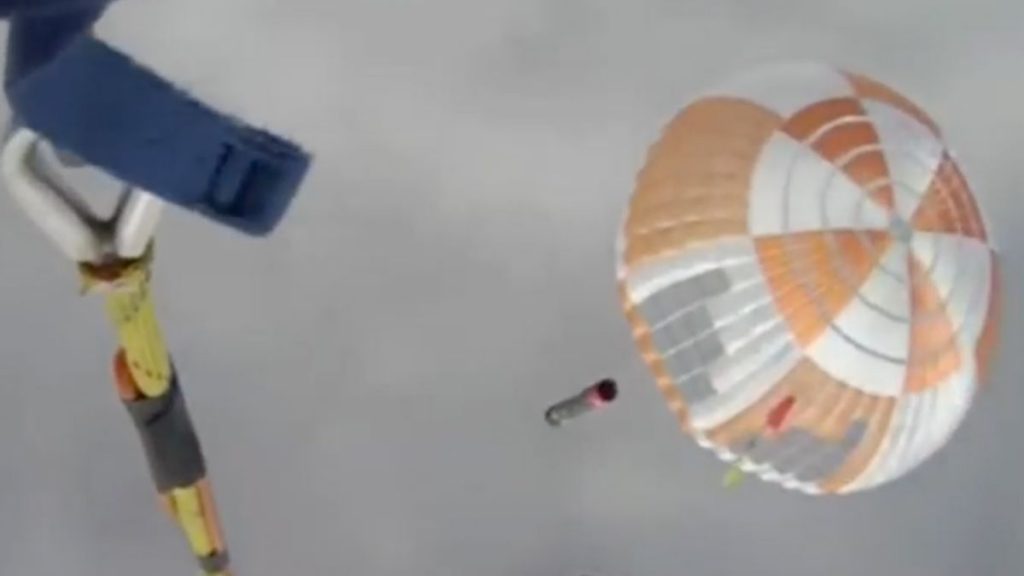Rocket Lab will launch a satellite to orbit and try to catch a falling booster with a helicopter on Friday (Nov. 4), and you can watch the action live.
Rocket Lab plans to launch a mission called “Catch Me If You Can” on Friday from its New Zealand site, during a 75-minute window that opens at 1:15 p.m. EDT (1715 GMT; 6:15 a.m. on Nov. 4 local New Zealand time).
You can watch it live here at Space.com, courtesy of Rocket Lab, or directly via the company (opens in new tab). Coverage will begin 20 minutes before liftoff.
The main goal Friday is to loft a research satellite for the Swedish National Space Agency (SNSA) using an Electron rocket, but most viewers will probably be more interested in a secondary objective — the recovery of the Electron’s falling first stage.
Related: Rocket Lab and its Electron booster (photos)
Rocket Lab aims to snatch the booster out of the sky with a helicopter, a strategy designed to keep the vehicle from getting dunked in corrosive seawater and to help ease its delivery back to terra firma for analysis and eventual reuse.
The 59-foot-tall (18 meters) Electron, a small-satellite launcher with 31 missions under its belt to date, is currently a completely expendable vehicle. Recovery and reuse of the first stage would allow Rocket Lab to boost its flight rate and reduce costs, company representatives have said.
Electron is too small to perform powered vertical landings, as SpaceX’s Falcon 9 and Falcon Heavy boosters do; it doesn’t have enough fuel left over after launch for such maneuvers. So Rocket Lab decided to go with the helicopter, which grabs ahold of Electron’s parachute line with a hook as the booster descends.
Rocket Lab has made some progress toward its reusability goal. For example, it has already performed one helicopter recovery, on a mission in May of this year called “There And Back Again.” (Rocket Lab likes to give its flights playful names, as you may have noticed.)
During that May mission, the helicopter — a Sikorsky S-92 — successfully snagged the Electron’s but accidentally dropped it into the drink shortly thereafter.
Rocket Lab fished the rocket out of the sea and hauled it back to shore by boat. The company analyzed the flown booster, then refurbished and tested one of its nine Rutherford engines, with promising results.
“The refurbished engine passed all of the same rigorous acceptance tests we perform for every launch engine, including 200 seconds of engine fire and multiple restarts,” company representatives wrote in the press kit for “Catch Me If You Can,” which you can find here (opens in new tab). The tests showed that the engine produced full thrust and “performed to the same standard of a newly built Rutherford engine,” they added.
Still, Rocket Lab would prefer to keep its boosters out of the water. On “Catch Me If You Can,” the company aims to keep the captured booster secured beneath the chopper for the entire flight to its Auckland Production Complex.
The helicopter catch will occur a little less than 19 minutes after liftoff, if all goes according to plan on “Catch Me If You Can.” The satellite, called MATS (“Mesospheric Airglow/Aerosol Tomography and Spectroscopy”), will be deployed about 41 minutes later.
MATS “is the basis for the SNSA’s science mission to investigate atmospheric waves and better understand how the upper layer of Earth’s atmosphere interacts with wind and weather patterns closer to the ground,” Rocket Lab wrote in the mission press kit.
MATS was originally supposed to launch atop a Russian rocket, but the SNSA and its main contractor for the satellite, OHB Sweden AB, nixed that agreement (opens in new tab) after the Russian invasion of Ukraine and rebooked on an Electron.
Mike Wall is the author of “Out There (opens in new tab)” (Grand Central Publishing, 2018; illustrated by Karl Tate), a book about the search for alien life. Follow him on Twitter @michaeldwall (opens in new tab). Follow us on Twitter @Spacedotcom (opens in new tab) or on Facebook (opens in new tab).

